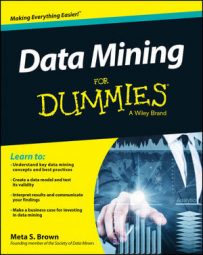Now that you are a data miner, you’re also a primary researcher. Sounds more scientific, doesn’t it? Your research is primary because you will begin from raw (basic, unprocessed) data and analyze it to add something new to the world’s knowledge.
You’ll probably also integrate some secondary research into your work. In other words, you’ll also make use of analyses that you or someone else did earlier. You might review internal documents to get up to date on what’s been done in your own organization or visit a library to read research papers.
You might obtain data that isn’t in its raw state but that has already been subjected to some processing analysis. For example, when you use recent census data, you don’t get information about individuals, but rather aggregate data that describes groups of people within some geographic region. Using that kind of data is also a form of secondary research.
In fact, you should never go out to collect new data by any means until you’ve looked into your options — not just for getting raw data, but also for taking advantage of any analysis of your subject that has already been done.
Primary research is what you do when nobody else has already done the work to develop the information you need. Make a habit of reviewing internal and external sources before you start any project so that you won’t end up wasting resources re-creating information that already exists.
It’s remarkable how much data you can get by asking for it. Loyalty programs are based on asking participants for their data, and millions of people around the world agree to participate. Surveys are nothing more than asking people for data, and you’d have a hard time finding any adult who hasn’t responded to at least one survey.
And these are valuable approaches to primary research. But some types of data still exist that you either can’t get or where you would not get good data quality just by asking for the information.
Software designers need to know how users view their designs. They may want to know where users focus their attention on a page, whether they are able to perform tasks in the intended manner, and how long it takes them to do things.
The designers could ask, but the users would probably have a hard time giving really effective feedback on these details. So software designers watch people using their software. They may do this directly by setting up stations where they can watch the users live and in person. Or they may use remote options based on the user’s keystrokes or video recording through web cameras.
If your government agency wants to know where in the world bomb-making, military training, or some other suspicious activity might be going on, you certainly won’t get the information by phoning all the world’s heads of government and asking for it. That’s why spies love satellites!
You may not need anything as fancy as a satellite to get the data you need, but you might benefit from down-to-earth data collection techniques like these:
Want to know where the shoppers at your mall have come from? Walk the parking lot and note the states on the license plates.
Don’t believe the foot traffic estimates from your local chamber of commerce? Stand on the street and count the passersby.
Aspire to make clothes that fit women better? Get out the measuring tape . . . please!

